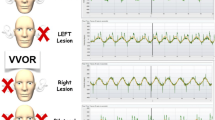Abstract
Patients with cerebellar lesions may show horizontal (positive)- or downward (perverted)-corrective saccades during horizontal head impulse test (HIT). However, corrective saccades in the direction of head rotation (reversed corrective saccades) have not been reported during HIT. We present two patients who showed reversed corrective saccades during horizontal HIT as an initial sign of acute cerebellitis. In contrast to the corrective saccades mostly observed in peripheral vestibular paresis, this paradoxical response indicates abnormally increased vestibulo-ocular responses due to cerebellar disinhibition over the vestibulo-ocular reflex. This paradoxical response should be considered an additional bedside cerebellar sign.


Similar content being viewed by others
References
Halmagyi GM, Curthoys IS. A clinical sign of canal paresis. Arch Neurol. 1988;45:737–9.
Fetter M, Dichgans J. Vestibular neuritis spares the inferior division of the vestibular nerve. Brain. 1996;119:755–63.
Leigh RJ, Zee DS. The neurology of eye movements. 4th ed. New York: Oxford University Press; 2006.
Lee H, Sohn SI, Cho YW, Lee SR, Ahn BH, Park BR, et al. Cerebellar infarction presenting isolated vertigo: frequency and vascular topographical patterns. Neurology. 2006;67:1178–83.
Kattah JC, Talkad AV, Wang DZ, Hsieh YH, Newman-Toker DE. HINTS to diagnose stroke in the acute vestibular syndrome: three-step bedside oculomotor examination more sensitive than early MRI diffusion-weighted imaging. Stroke. 2009;40:3504–10.
Kremmyda O, Kirchner H, Glasauer S, Brandt T, Jahn K, Strupp M. False-positive head-impulse test in cerebellar ataxia. Front Neurol. 2012;3:162.
Park HK, Kim JS, Strupp M, Zee DS. Isolated floccular infarction: impaired vestibular responses to horizontal head impulse. J Neurol. 2013;260:1576–82.
Jeong SH, Kim JS, Baek IC, Shin JW, Jo H, Lee AY, et al. Perverted head impulse test in cerebellar ataxia. Cerebellum. 2013;12(5):773–5.
Thurston SE, Leigh RJ, Abel LA, Dell'Osso LF. Hyperactive vestibulo-ocular reflex in cerebellar degeneration: pathogenesis and treatment. Neurology. 1987;37:53–7.
Baloh RW, Demer JL. Optokinetic–vestibular interaction in patients with increased gain of the vestibulo-ocular reflex. Exp Brain Res. 1993;97:334–42.
Walker MF, Zee DS. Directional abnormalities of vestibular and optokinetic responses in cerebellar disease. Ann N Y Acad Sci. 1999;871:205–20.
Demer JL, Robinson DA. Effects of reversible lesions and stimulation of olivocerebellar system on vestibuloocular reflex plasticity. J Neurophysiol. 1982;47:1084–107.
Ito M. Cerebellar flocculus hypothesis. Nature. 1993;363:24–5.
Belton T, McCrea RA. Role of the cerebellar flocculus region in cancellation of the VOR during passive whole body rotation. J Neurophysiol. 2000;84:1599–613.
Zee DS, Yamazaki A, Butler PH, Gucer G. Effects of ablation of flocculus and paraflocculus of eye movements in primate. J Neurophysiol. 1981;46:878–99.
Schultheis LW, Robinson DA. Directional plasticity of the vestibuloocular reflex in the cat. Ann N Y Acad Sci. 1981;374:504–12.
Killian JE, Baker JF. Horizontal vestibuloocular reflex (VOR) head velocity estimation in Purkinje cell degeneration (pcd/pcd) mutant mice. J Neurophysiol. 2002;87:1159–64.
Moon IS, Kim JS, Choi KD, Kim MJ, Oh SY, Lee H, et al. Isolated nodular infarction. Stroke. 2009;40:487–91.
Solomon D, Cohen B. Stimulation of the nodulus and uvula discharges velocity storage in the vestibulo-ocular reflex. Exp Brain Res. 1994;102:57–68.
Conflict of Interest
No conflicting relationship exists for the authors.
Disclosure
Dr. J-S Kim serves as an Associate Editor of Frontiers in Neuro-otology and on the editorial boards of the Journal of Clinical Neurology, Frontiers in Neuro-ophthalmology, Journal of Neuro-ophthalmology, and Journal of Vestibular Research, and received research support from SK Chemicals, Co. Ltd. The other authors have nothing to disclose.
Author information
Authors and Affiliations
Corresponding author
Electronic supplementary material
Below is the link to the electronic supplementary material.
ESM 1
JPEG 491 kb
ESM 2
JPEG 508 kb
Both patients show increased gain of the vestibulo-ocular reflex (VOR) and reversed corrective saccades during horizontal head impulse test (HIT) (paradoxical head impulse sign). In patient 2, perverted corrective saccade was also noted during head impulse to the right (WMV 36,251 kb)
Rights and permissions
About this article
Cite this article
Choi, JY., Kim, JS., Jung, JM. et al. Reversed Corrective Saccades during Head Impulse Test in Acute Cerebellar Dysfunction. Cerebellum 13, 243–247 (2014). https://doi.org/10.1007/s12311-013-0535-2
Published:
Issue Date:
DOI: https://doi.org/10.1007/s12311-013-0535-2




